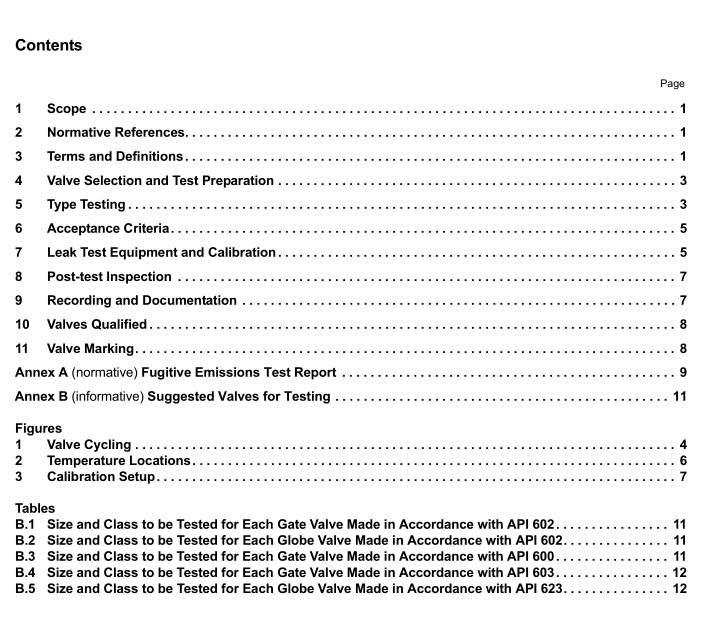API St 624 pdf download

API St 624 pdf download Type Testing of Rising Stem Valves Equipped with Graphite Packing for Fugitive Emissions
4Valve Selection and Test Preparation
4.1The APl 622 certficate or test report for the packing in the test valve shall be provided and attached to the API624 fugitive emissions test report.
4.2The test valve shall be completely assembled and ready for testing. The test valve shall be randomly selectedfrom manufacturer or distributor stock where such stock is available.For valves not in stock, the manufacturer shallcertify that the test valve was not modified in any way to meet type test requirements and is a typical representation ofthe manufacturer’s stock product. Valve selection shall be approved by the purchaser,
4.3Body-bonnet and gland bolting torque shall be verified to be in accordance with published manufacturer’sinstallation specifications.
4.4 All pre-test activities to the valve shall be documented on the Fugitive Emissions Test Report in Annex A.4.5 As a safety precaution, the air in the valve cavity shall be purged with an inert gas prior to starting the testing.5 Type Testing
5.1 The test medium used shall be methane 97 % minimum purity.
Caution—Methane used during testing is a pressurized flammable gas which requires that appropriate safetymeasures be taken.
5.1.1Testing of valves is potentially hazardous and it is essential that the safety of personnel be given primeconsideration.Given the nature of this test, hazardous release of pressurized gas could occur. Adequate shields orbarriers in the area of the test enclosure and other appropriate means for the protection of personnel shall beprovided.
5.1.2 The test facilities shall be designed to ensure that all the test conditions are conducted in a safe and protectedenvironment. lt is the responsibility of the testing facility to analyze the hazards resulting from the pressure andtemperatures and take proper safety precautions.All applicable safety regulations shall be complied with.
5.1.3 All equipment shall have appropriate certification that verifies its suitability to withstand the minimum andmaximum pressures and temperatures in the testing environment.
5.1.4 Hoses or pipes used for inlet and outlet supply of methane shall be suitable for maximum pressures andtemperatures.Where hoses are used, appropriately designed restraints shall be used to prevent hose detachmentfrom the test rig in the event that a blow-out occurs.
5.1.5 All testing shall be in accordance with local and national codes and regulations.5.2The stem orientation for a test valve shall be vertical.
5.3Valves shall be subjected to a total of 310 mechanical cycles and 3 thermal cycles per Figure 1.Mechanicalcycling shall begin with the valve at ambient temperature.An optional low temperature test at-29C(-20 °F) may beperformed if requested by the purchaser (see Figure 1).
5.4The valve shall be heated using an internal heat source or an external heat source such as electric heatingblanket, coils, or other suitable equipment or an appropriate internal heat source.
5.5The elevated test temperature shall be 260°C (500 °F) 15 percent.
5.6 The test pressure shall be the lower of 41.4 barg (600 psig) or the maximum allowable pressure at 260 “c(500 °F) per ASME B16.34 for the applicable material group and shall be held constant throughout the test.
5.7 The test valve may be equipped with a method of actuation capable of mechanically cycling the valve. Themethod of actuation should not impose additional side loads on the stem or packing.Running torque values shall berecorded on the first and last cycle of testing.
5.8Static and dynamic stem leakage measurements shall be taken.See Figure 1.
5.8.1 Leak measurements shall be conducted in still air. Shielding potential leak paths from environmental impactswith a foil enclosure shall be employed during testing. The foil enclosure shall include the stem outside diameter andpacking outside diameter.
5.8.2 Leak measurements of the body-bonnet connection and auxiliary connections shall be sniffed. Leakage frombody-bonnet and auxiliary connections can affect leak measurement readings and shall be corrected prior tocontinuation of the test and noted in the report. The detector probe speed shall be approximately 25 mm (1 in.) persecond for the bonnet. The instrument shall be adjusted to compensate for the background methane level.
5.8.3 The staticldynamic leakage shall be recorded after a time delay of twice the response time of the instrument.5.9The valve shall be equipped with thermocouples for monitoring the temperature during testing.The temperatureshall be monitored and recorded at two locations (see Figure 2).
5.9.1 TC-1—affxed to the stuffing box. The thermocouple affixed to the stuffing box shall control the testtemperature.
5.9.2 TC-2—at the external body adjacent to the flow path shall be a reference measurement.5.9.3 TC-2—shall be equal to or greater than TC-1.
5.10Packing adjustment during type testing is not permitted.
6 Acceptance Criteria
The Fugitive Emissions Test Report in Annex A shall indicate “pass” when the measured leakage throughout the testdoes not exceed 100 ppmv.
7 Leak Test Equipment and Calibration
7.1 Monitoring equipment shall be as described below capable of providing on-board data logging with digitalreadout. The equipment shall be certified as intrinsically safe for use with the test medium. Data logging may also beperformed with a separate data acquisition system.









